|
|
【纪念当年的帖子(2008)】高級數學纲要笔记
 [复制链接]
[复制链接]
|
|
|

楼主 |
发表于 2-1-2009 01:50 AM
|
显示全部楼层
注意:
以下是之前零散帖子的微分总结:
remember, you cant memorize the steps, you need to understand the logic behind the theorem..
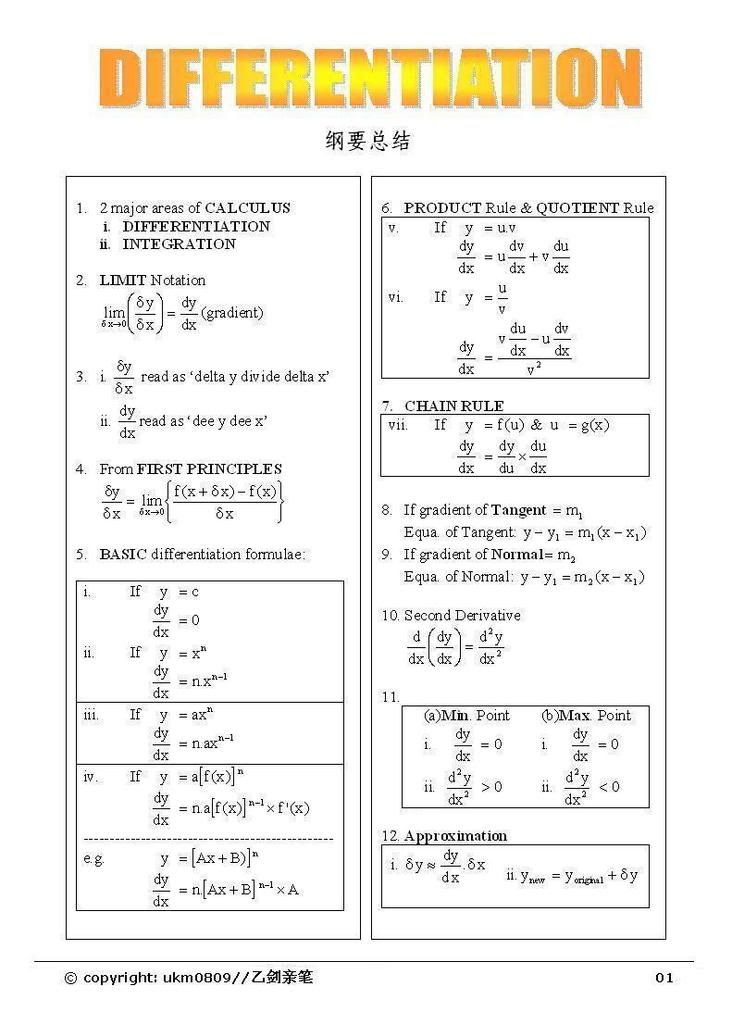
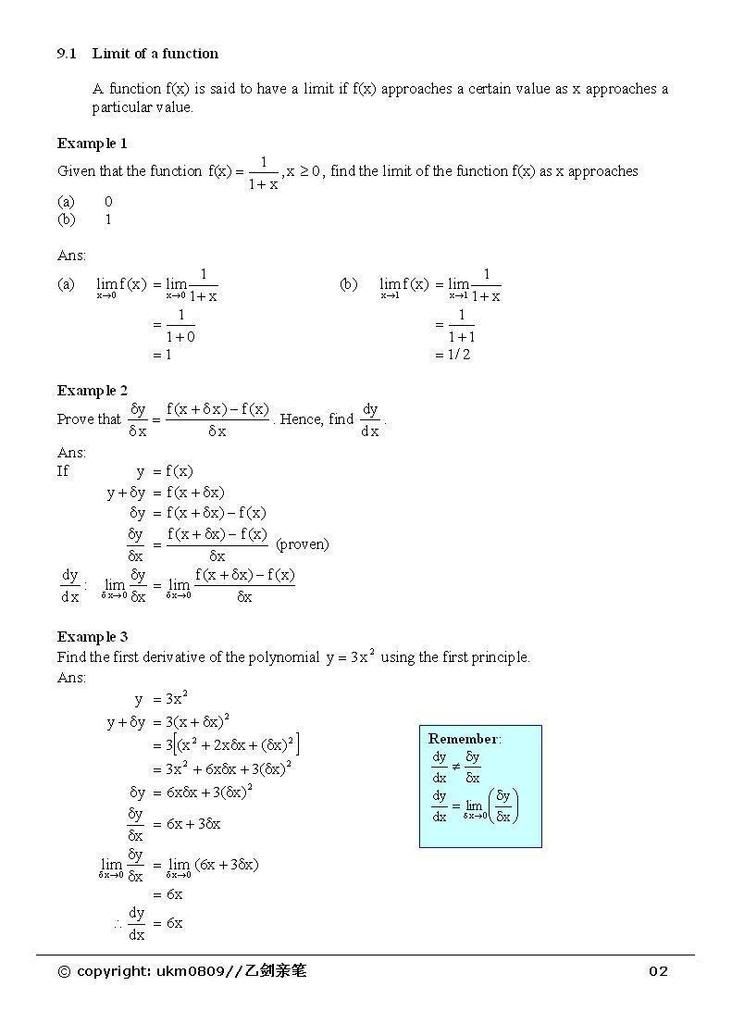
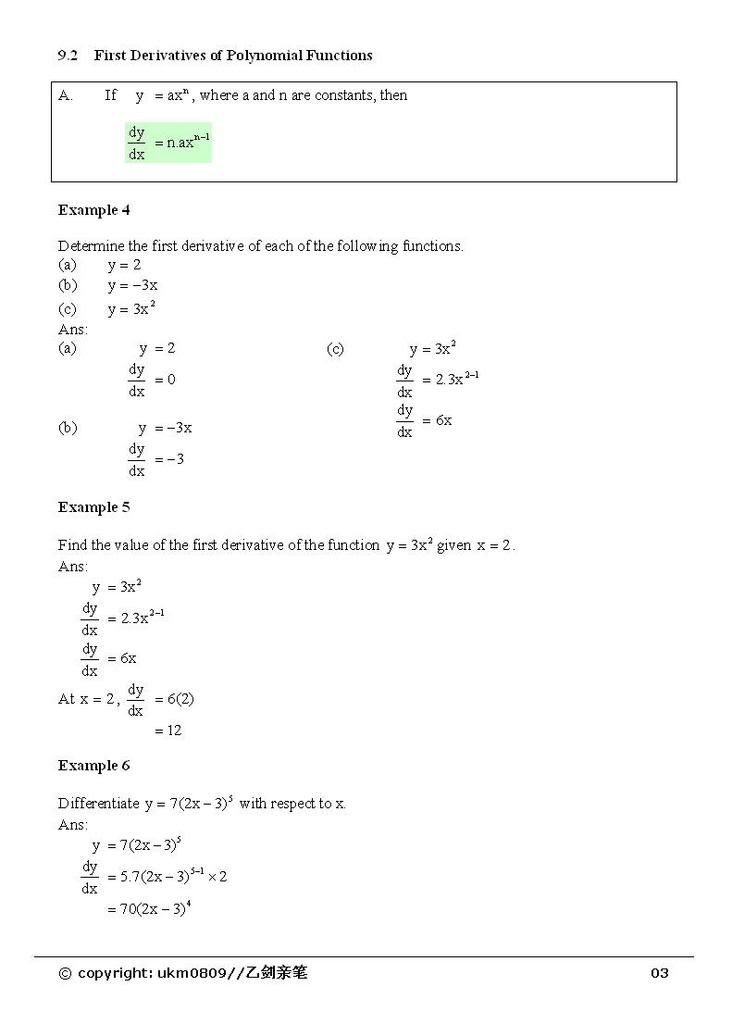
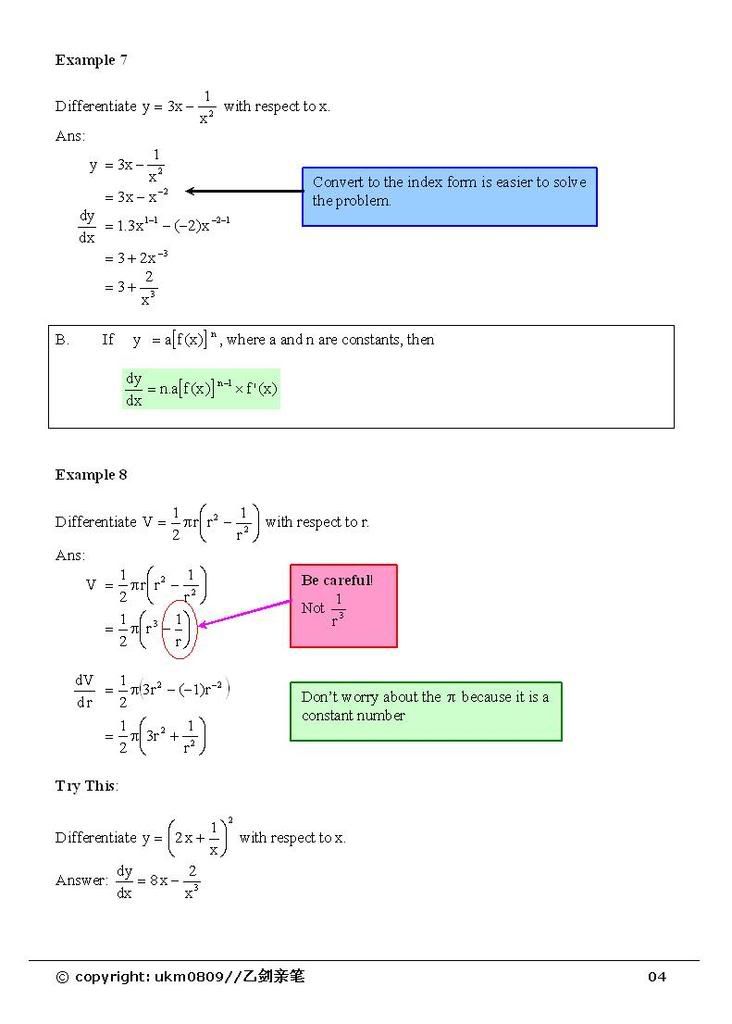
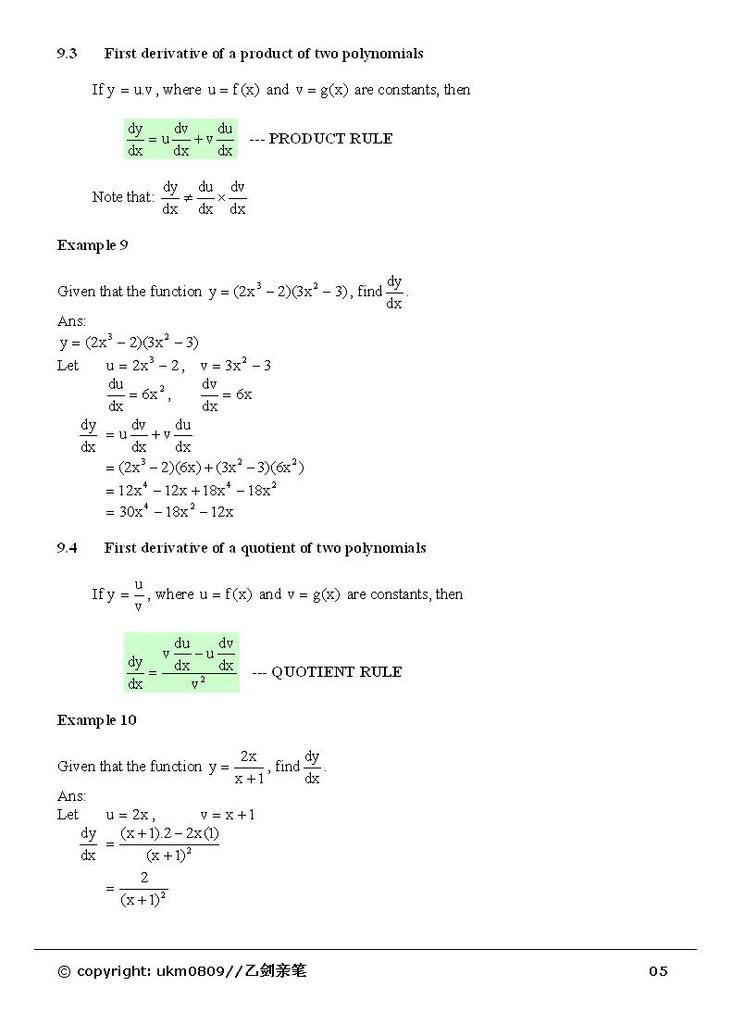
Small Changes and Approximations
我就照白羊的题目讲解这一部分吧..
原帖由 白羊座aries 于 4-10-2008 07:35 PM 发表 
Determine the approximate value of square root of 3.99 by using differentiation method
首先:Let y = sqrt x
= x power of 1/2
dy/dx = 1/(2sqrt x)
接着,we use x = 4 to substitute into dy/dx because 3.99 approximately to 4.
i.e. dy/dx = 1/4
Delta x = 3.99 - 4 = -0.01
i.e. sqrt 3.99 = sqrt 4 + (dy/dx x Delta x)
= 2 + 1/4(-0.01)
= 2 - 0.0025
= 1.9975
9.5 Equation of the tangent to a curve at a point
Formula:y - y1 = m(x-x1)
Example 11:
Find the equation of the tangent to the curve y = x^2 - 4x + 3 at point (3,4).
Solution:
y = x^2 - 4x + 3
dy/dx = 2x - 4
At point (3,4), dy/dx = 2(3) - 4 = 2
i.e. gradient of the tangent(m) = 2
therefore, equation of the tangent at point (3,4) is
y - 4 = 2(x - 3)
= 2x - 6
y = 2x - 2
9.6 Equation of the normal to a curve at a point
Formula:y - y1 = n(x-x1)
Example 12:
Find the equation of the normal to the curve y = x^2 - 4x + 3 at point (3,4).
Solution:
y = x^2 - 4x + 3
dy/dx = 2x - 4
At point (3,4), dy/dx = 2(3) - 4 = 2
i.e. gradient of the tangent(m) = 2
gradient of the normal(n) = -1/2 (m x n = -1)
therefore, equation of the normal at point (3,4) is
y - 4 = -1/2(x - 3)
= -x + 3
2y = -x + 11
9.7 Rates of Change
In cases where three variables are involved, say y = f(x) and x = f(t), then
dy/dt = dy/dx x dx/dt
Example 13:
The radius of a sphere increases at a rate of 0.7 cm s ^-1.
At the instant when its radius is 6 cm, find the rate of change of
(a) the volume of the sphere
(b) the total surface area of the sphere
Solution:
Let r, V and A be the radius, volume and total surface area of the sphere respectively.
(a) V = 4/3 pi r ^3
dV/dr = 4 pi r ^2
dV/dt = dV/dr x dr/dt
= 4 pi r ^2 x 0.7
= 2.8 pi r ^2
When r = 6 cm, dV/dt = 2.8 pi(6^2)
= 100.8 pi cm ^3 s ^-1
(b) A = 4 pi r ^2
dA/dr = 8 pi r
dA/dt = dA/dr X dr/dt
= 8 pi r x 0.7
= 5.6 pi r
When r = 6 cm, dA/dt = 5.6 pi(6)
= 33.6 cm ^2 s ^-1
9.8 Second Derivative
d/dx(dy/dx) = d^2y/dx^2
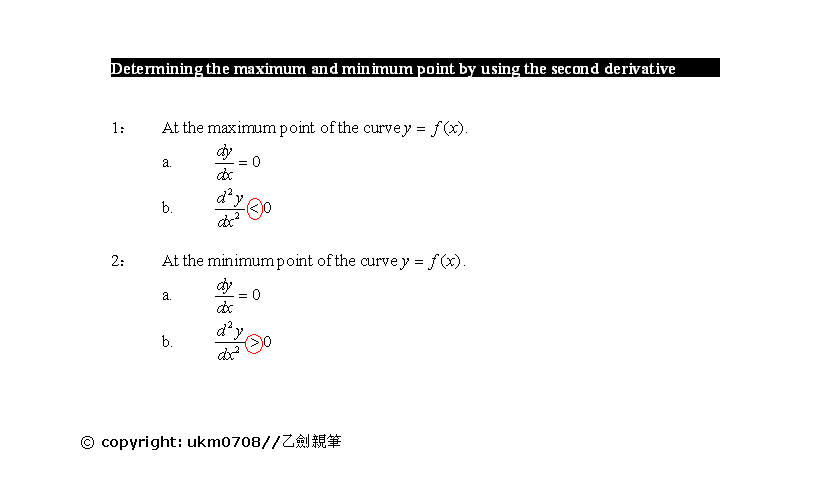
Example 14:
Find the turning points for the curve with equation y = x ^3 + x ^2 - x + 5.
Hence, determine the type of turning points.
Solution:
y = x ^3 + x ^2 - x + 5
dy/dx = 3x ^2 + 2x - 1
For turning points, dy/dx = 0
x = -1, x = 1/3
Substitute x = -1 and x = 1/3 into equation y respectively.
i.e. when x = -1, y = 6
when x = 1/3, y = 130/27
The turning point are (-1,6) and (1/3, 130/27)
d^2y/dx^2 = 6x + 2
For (-1, 6), d^2y/dx^2 = -4 <0
i.e. (-1, 6) is maximum point
For (1/3, 130/27), d^2y/dx^2 = 4 >0
i.e. (1/3, 130/27) is minimum point
以上仅属于一般复习的题目,欲更了解细节,请参考坊间的参考书。
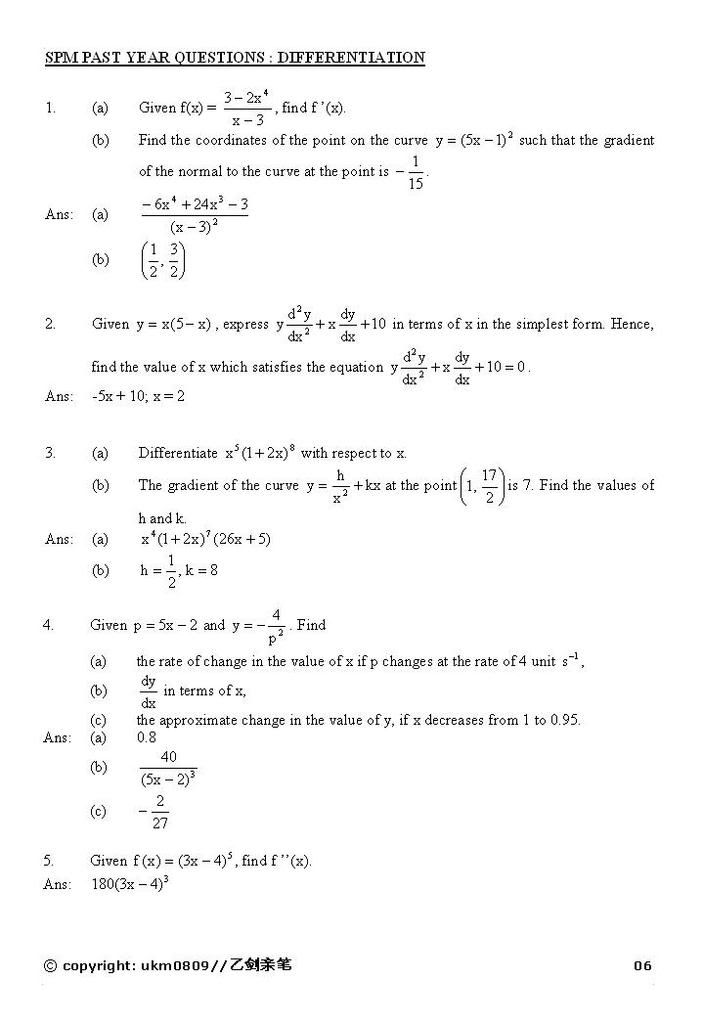
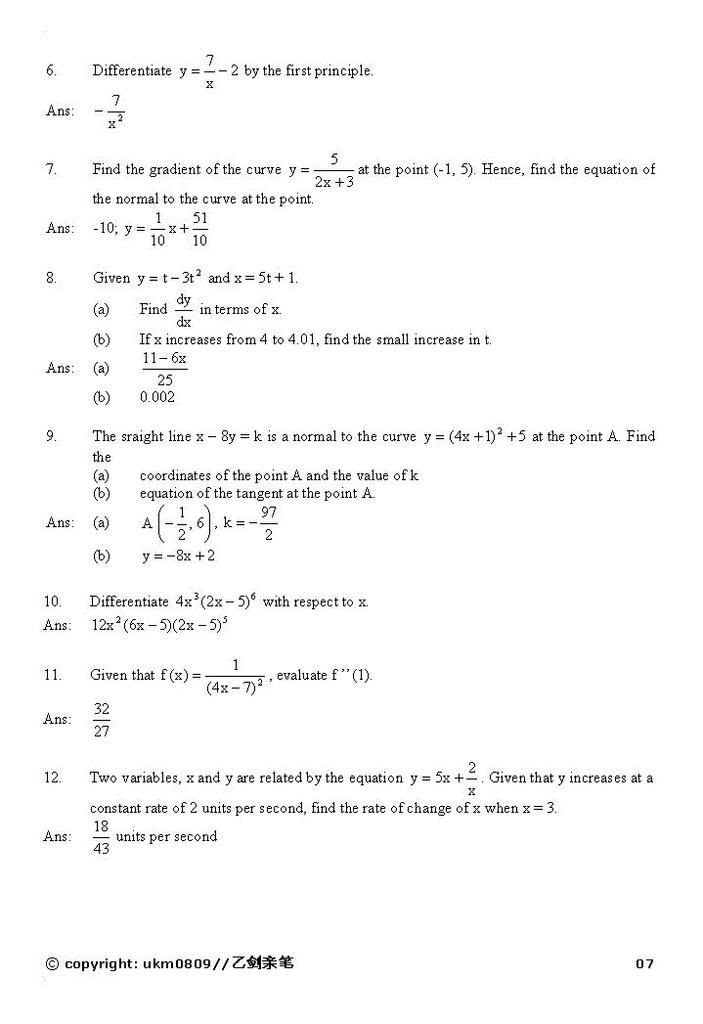
以上乃微分很小的一部分,迟些我再补充资料.. 大家加油! |
|
|
|
|
|
|
|
|
|
|
|
 发表于 3-1-2009 09:21 PM
|
显示全部楼层
发表于 3-1-2009 09:21 PM
|
显示全部楼层
我今年form 4但是我已经学了addmaths两个chapter
有几个问题我不太明白所以希望你们帮我解答
1) The quadratic equation (x+m)^2 = kx has the roots 1 and 16. Find the values of m and the corresponding values of k
2) The roots of quadratic equation 3x^2 + px + 2 = 0 are in the ratio 2:3
(A) find the value of p if p>0
(B) hence,find the roots of the equation
3) One of the roots of the equation 9x^2 - 9(k+2)x + 9k^2 + 18k + 11 = 0 is two times the other root. Find the values of k. |
|
|
|
|
|
|
|
|
|
|
|

楼主 |
发表于 5-1-2009 10:39 AM
|
显示全部楼层
原帖由 wkn1ght93 于 3-1-2009 09:21 PM 发表 
我今年form 4但是我已经学了addmaths两个chapter
有几个问题我不太明白所以希望你们帮我解答
(1) The quadratic equation (x+m)^2 = kx has the roots 1 and 16.
Find the values of m and the corresponding values of k.
SOLUTION:
Let the roots x = 1 and x = 16, hence substitute the roots into the equation.
(1 + m)^2 = k(1)
1 + 2m + m^2 = k ---(1)
(16 + m)^2 = k(16)
256 + 32m + m^2 - 16k = 0 ---(2)
Substitute (1) into (2):
256 + 32m + m^2 - 16(1 + 2m + m^2) = 0
256 + 32m + m^2 - 16 - 32m - 16m^2 = 0
-15m^2 + 240 = 0
m = +/- 4
When m = 4, k = 1 + 2(4) + (4)^2
= 25
When m = - 4, k = 1 + 2(- 4) + (- 4)^2
= 9
Hence, the solutions are m = 4, k = 25 ; m = - 4, k = 9
(2) The roots of quadratic equation 3x^2 + px + 2 = 0 are in the ratio 2:3,
(a) Find the value of p if p>0.
(b) Hence, find the roots of the equation.
SOLUTION:
(a) Let the roots x = 2A and x = 3A . Hence, substitute the roots into the equation.
3(2A)^2 + p(2A) + 2 = 0
12A^2 + 2Ap + 2 = 0 ---(1)
3(3A)^2 + p(3A) + 2 = 0
27A^2 + 3Ap + 2 = 0 ---(2)
From (1), p = -6A - 1/A ---(3)
Substitute (3) into (2):
27A^2 + 3A(-6A - 1/A) + 2 = 0 ---(4)
27A^2 - 18A^2 - 3 + 2 = 0
9A^2 = 1
A = +/- 1/3 ---(5)
When A = 1/3, from (3), p = -6(1/3) - 1/(1/3)
p = -5
When A = -1/3, from (3), p = -6(-1/3) - 1(-1/3)
p = 5
Since p > 0, then p = 5
(b) Substitute p = 5 into the given equation,
3x^2 + px + 2 = 0
3x^2 + 5x + 2 = 0
(3x + 2)(x + 1) = 0
x = -2/3 or x = -1
OR:
x = 2(-1/3)
= -2/3
x = 3(-1/3)
= -1
(3) One of the roots of the equation 9x^2 - 9(k+2)x + 9k^2 + 18k + 11 = 0 is two times the other root.
Find the values of k.
SOLUTION:
9x^2 - 9(k + 2)x + 9k^2 + 18k + 11 = 0
We notice that a = 9, b = -9(k + 2), c = 9k^2 + 18k + 11
Sum Of Roots, SOR = -b/a
= -(-9(k + 2) /9)
= -(-k - 2)
= k + 2
Product Of Roots, POR = c/a
= (9k^2 + 18k + 11)/9
Let the roots x = A and x = 2A because one of the root twice the other one.
SOR, A + 2A = k + 2
3A = k + 2
A = (k + 2)/3 ---(1)
POR, A(2A) = (9k^2 + 18k + 11)/9
2A^2 = (9k^2 + 18k + 11)/9 ---(2)
Substitute (1) into (2):
2((k + 2)/3)^2 = (9k^2 + 18k + 11)/9
(2/9)(k^2 + 4k + 4) = (9k^2 + 18k + 11)/9
2k^2 + 8k + 8 = 9k^2 + 18k + 11
7k^2 + 10k + 3 = 0
(7k + 3)(k + 1) = 0
k = -3/7 or k = -1 |
|
|
|
|
|
|
|
|
|
|
|
 发表于 6-1-2009 10:44 PM
|
显示全部楼层
发表于 6-1-2009 10:44 PM
|
显示全部楼层
这贴太棒了!楼主太好了!我支持,大家一起加油 |
|
|
|
|
|
|
|
|
|
|
|
 发表于 6-1-2009 10:49 PM
|
显示全部楼层
发表于 6-1-2009 10:49 PM
|
显示全部楼层
我高数不及格啊 !!!!!!!
得温习多点!!!
谢谢楼主的分享 |
|
|
|
|
|
|
|
|
|
|
|

楼主 |
发表于 7-1-2009 01:43 PM
|
显示全部楼层
|
|
|
|
|
|
|
|
|
|
|
 发表于 10-1-2009 08:44 PM
|
显示全部楼层
发表于 10-1-2009 08:44 PM
|
显示全部楼层
请问这题 if the first two terms of an A.P ARE 1.3 AND 1.9 respestively,find the first term which is greater than 20.7怎样做? 帮帮忙 帮帮忙 |
|
|
|
|
|
|
|
|
|
|
|

楼主 |
发表于 10-1-2009 09:50 PM
|
显示全部楼层
原帖由 genesistj 于 10-1-2009 08:44 PM 发表 
请问这题 if the first two terms of an A.P ARE 1.3 AND 1.9 respestively,
find the first term which is greater than 20.7怎样做? 帮帮忙 帮帮忙
嗯..不要哭乖
AP: 1.3, 1.9, ...
a = 1.3, d = 1.9 - 1.3
= 0.6
a + (n - 1) d > 20.7
1.3 + (n - 1)0.6 > 20.7
1.3 + 0.6n - 0.6 > 20.7
0.6n > 20
n > 33.33
i.e. n = 34
T34 = 1.3 + (34 - 1) 0.6
= 21.1
i.e. the first term which is greater than 20.7 is 21.1..
还有一个方法,不过长了点
就是单纯一个加一个,加到号码大过 20.7.. 
e.g. 1.3, 1.9, 2.5, ...... , 19.9, 20.5, 21.1 |
|
|
|
|
|
|
|
|
|
|
|
 发表于 11-1-2009 12:16 PM
|
显示全部楼层
发表于 11-1-2009 12:16 PM
|
显示全部楼层
谢谢 ,原来是这样,我真笨 ,原来是这样,我真笨 以后有问题可以再问你吗?? 以后有问题可以再问你吗?? |
|
|
|
|
|
|
|
|
|
|
|

楼主 |
发表于 11-1-2009 12:33 PM
|
显示全部楼层
|
|
|
|
|
|
|
|
|
|
|

楼主 |
发表于 11-1-2009 12:52 PM
|
显示全部楼层
Announcement:
大家只需按首页目录就可以浏览每个chapter 的资料!  |
|
|
|
|
|
|
|
|
|
|
|
 发表于 11-1-2009 12:56 PM
|
显示全部楼层
发表于 11-1-2009 12:56 PM
|
显示全部楼层
|
|
|
|
|
|
|
|
|
|
|

楼主 |
发表于 11-1-2009 01:10 PM
|
显示全部楼层
|
|
|
|
|
|
|
|
|
|
|
 发表于 17-1-2009 03:37 PM
|
显示全部楼层
发表于 17-1-2009 03:37 PM
|
显示全部楼层
好料...太感动了... |
|
|
|
|
|
|
|
|
|
|
|
 发表于 17-1-2009 03:58 PM
|
显示全部楼层
发表于 17-1-2009 03:58 PM
|
显示全部楼层
回复 293# 乙劍真人 的帖子
其他人我不知道,不過mathlim還沒有退隱啦~
他是在潛水~  |
|
|
|
|
|
|
|
|
|
|
|
 发表于 18-1-2009 10:51 AM
|
显示全部楼层
发表于 18-1-2009 10:51 AM
|
显示全部楼层
请问下evaluate the geometric series 2+6+...+4374 怎么做? |
|
|
|
|
|
|
|
|
|
|
|
 发表于 18-1-2009 02:07 PM
|
显示全部楼层
发表于 18-1-2009 02:07 PM
|
显示全部楼层
原帖由 genesistj 于 18-1-2009 10:51 AM 发表 
请问下evaluate the geometric series 2+6+...+4374 怎么做?
Evaluate the G.S. 2 + 6 + ... + 4374.
First term, a = 2
Common ratio, r = 6/2 = 3
Let nth term, T_n = 4374
ar^(n - 1) = 4374
(2)3^(n - 1) = 4374
3^(n - 1) = 2187
3^(n - 1) = 3^7
n - 1 = 7
n = 8
2 + 6 + ... + 4374 = {2[(3^8) - 1]} / 3 -1
= (3^8) - 1
= 6560
[ 本帖最后由 Ivanlsy 于 18-1-2009 02:11 PM 编辑 ] |
|
|
|
|
|
|
|
|
|
|
|
 发表于 18-1-2009 07:39 PM
|
显示全部楼层
发表于 18-1-2009 07:39 PM
|
显示全部楼层
原来是这样,谢谢你 |
|
|
|
|
|
|
|
|
|
|
|
 发表于 19-1-2009 08:58 PM
|
显示全部楼层
发表于 19-1-2009 08:58 PM
|
显示全部楼层
|
|
|
|
|
|
|
|
|
|
|
 发表于 24-1-2009 10:12 PM
|
显示全部楼层
发表于 24-1-2009 10:12 PM
|
显示全部楼层
|
|
|
|
|
|
|
|
|
| |
 本周最热论坛帖子 本周最热论坛帖子
|